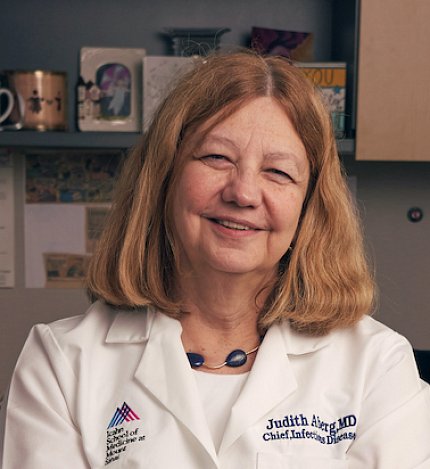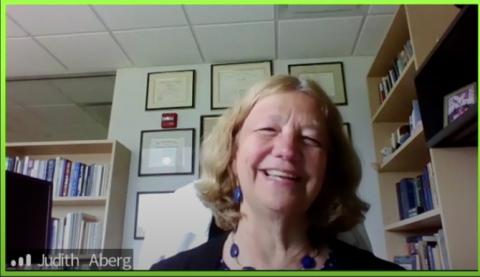Early Epicenter
Aberg Offers Clinical Lessons from NYC Frontlines

It must have been some comfort for Covid-19 patients entering Mt. Sinai Hospital (MSH) in New York at the height of the city’s pandemic in early April—when the 7-hospital medical system was admitting upwards of 2,000 patients a day—to come under the care of Dr. Judith Aberg.
“She knows how to treat patients from Ebola, to Zika, to Covid-19,” said NIAID clinical director Dr. Cliff Lane, who introduced Aberg’s July 8 lecture in the Covid-19 scientific interest group lecture series. “She is an amazing clinical investigator, from HIV to the present time.”
“It has really been a devastating time for so many,” said Aberg, who is chief of infectious diseases at Icahn School of Medicine at Mt. Sinai and a member of the panel developing NIH Covid-19 treatment guidelines. “The outer boroughs were hit much harder than Manhattan itself…We had 80 deaths per day some days. I am in awe of our frontline providers.”
Only 17 percent of the total number of Covid-19 patients admitted to Mt. Sinai Hospital in Manhattan died, she said; 30 percent who were treated in Brooklyn died. “This represents disparities—crowded households, lack of access to health care.”
The first U.S. case was reported on Jan. 21. In New York City, the first covid ER admission was on Feb. 29. MSH admitted its first patient on Mar. 7, but by Apr. 9, Mt. Sinai Health System (MSHS) was treating over 2,000 patients daily, which required the erection of medical tents in Central Park and conversion of MSH’s lobby into a covid ward made up of patient cubicles.
“The whole hospital pretty much became a covid hospital—essentially ICUs and step-down units,” said Aberg.
“We are down to about 100 patients now,” she said, expressing gratitude that the acute phase of the pandemic crested unexpectedly early in her city. “It was overwhelming to see so many individuals as sick as they were.”
One case stood out: a man who had been ill at home for 2 weeks before arriving at the hospital with fever, respiratory problems, diarrhea and development of neurological symptoms. He died on the 23rd day of his hospital stay.
“We were not anticipating this,” Aberg said. “We expected a pneumonia-like disease and treatment requiring ventilators.”
Instead they encountered, on the man’s autopsy, micro-thrombi, or blood clots in his brain.
“This virus seems to have a predilection for the lining of the blood vessels,” she said. “That was a surprise to us…So many times with Covid-19, we are saying ‘I don’t know.’”
Aberg’s clinical challenges included shortages of PPE (personal protective equipment); at one point she was asked to start Googling for manufacturers that sold hospital-grade masks.
“We always had an adequate number, but brands and types were different, and the staff needed instruction on using them, and fit-testing.”
At one point, MSH went to double-bedded intensive care units, “but we were lucky we didn’t need split ventilators,” Aberg said.
Showing a slide of the ICU, she said caregivers relied on remote monitoring, to keep themselves safe. Tubing in some units ran along floors and under doors, “which is an alarming sight for any infectious disease doctor…It’s a very delicate balance between providing care and keeping staff safe.”
Relying on advice from China, Italy and other countries hit hard by Covid-19, Aberg drafted clinical treatment guidelines that were modified and approved by a multidisciplinary team. They were updated so frequently that new PDF versions were being published weekly, sometimes daily. Just-in-time training sessions also became the norm.

“More than 90 staff from our cancer and medicine clinical trials department were recruited,” Aberg recalls. “They helped us roll out studies. There was a tremendous sense of camaraderie. All disciplines were doing everything we could, together.”
The first patient they treated with remdesivir survived—a small victory.
On Mar. 19, MSHS launched its first clinical trial. “That usually takes 3 months,” Aberg noted.
They got a Regeneron protocol—involving sarilumab, a monoclonal antibody against the interleukin-6 receptor—approved within days.
“That’s unprecedented,” said Aberg, “that a clinical trial could open so rapidly.”
She said MSHS “jumped on hydroxychloroquine [HCQ], like everybody else in the country,” until evidence proved it was ineffective.
“It fell out of favor early, because we saw the harm—QT prolongation in about 8 percent of our patients. I credit the establishment of treatment guidelines leading to improved patient outcomes to the incredible teamwork throughout our system.”
On Mar. 28, MSH began convalescent plasma transfusion via an eIND (emergency investigational new drug application) in a cohort of 39 adults and 1 child, all of whom received plasma from donors who had high levels of covid antibodies; Aberg had been introduced to the approach during a 2009 NIH-supported study of H1N1 flu treatments.
“By Apr. 17, we were transfusing plasma in all 7 of our hospitals,” she said, noting that the therapy is probably most effective when given earlier in the course of illness.
On Apr. 7, a protocol on corticosteroids began when intensivists at Mt. Sinai West found it beneficial. Aberg’s colleague Dr. Andy Dunn developed an algorithm to begin anticoagulation therapy in certain patients.
“We had developed a clinical pathway by mid-April,” said Aberg, which governed how to treat Covid-19 patients along the spectrum from mild, to moderate, to severe cases.
“We kept simplifying it by changing dense text to graphic figures, making it easier to read and understandable for the teams on the wards,” she said.
MSHS also experienced drug shortages, including HCQ and tocilizumab, or “toci.”
“Families would come to the security desk at the hospital with vials of toci, but we just could not use them,” said Aberg, noting that no chain of custody could be established for these products. A couple brought stem cells, too, in response to newspaper accounts in Israel that they could be effective.
“The sheer volume of patients created a sense of overwhelming hopelessness,” said Aberg, who was also frustrated by having to tell families, with fatiguing frequency, that caregivers simply didn’t know all the answers.
“That’s tough to do with a patient right in front of you who might die,” she said.
Other challenges included the consent process—not all patients could do it, Aberg noted. There were briefly worries that the paperwork itself could be a vector of virus transmission.
There were ethical issues involving drugs used for off-label purposes. Sometimes clinical trials were competing for the same patient population.
Then there was the problem of entitlement: people insisting that their loved one is more deserving than another’s.
“Everyone is someone to somebody—that’s true of all patients,” Aberg said. “We were faced with so many grievances—we got hit with the anger. It created a lot of discomfort. There was nothing we could do at times. Families and providers were frustrated.”
MSHS ended up opening a Center for Stress, Resilience and Personal Growth so that its employees could better manage their stress. “In February, as we were anticipating covid, we activated our emergency management operations center, which remains at a lower level now but prepared and ready to engage as needed for this and any health care crisis,” said Aberg. A plasma collection center, too, is opening at MSH later this summer.
In a world where social media reports are frequently unreliable, and scientific pre-prints are accorded unwarranted authority, Aberg urges the public, “Call us. We can help you sort out what’s real and not real. And don’t wait to seek medical care—many people stayed home sick, and ended up getting really short of breath before coming in.”
At one point, she fielded a call from a person on Long Island who believed that his family ought to ingest crushed chlorine tablets used to sanitize the family pool; another short-lived fad was high-dose ivermectin, used to treat parasites.
Overall, Aberg is heartened by her profession’s response to the global pandemic.
“We have many more options now than we had in February and early March—antivirals, immune-based therapies, steroids, anticoagulants…We really did come together as a faculty…We’re in a much better place now, if we have a second wave.”
During a brief Q&A session, Aberg said that reports of long-term sequelae of Covid-19 infection, including chronic lung disease and cardiac complications, are likely real. “Acute lung injury becomes chronic, acute kidney injury becomes chronic. And I think the neurological complications have been underestimated. We’ve heard reports of ‘brain fog’ in people in their 30s and 40s. Some have PTSD after what they’ve gone through. Many are on home oxygen. We think that about 10 percent of patients may wind up with long-term complications.”
She also warned of the upcoming flu season, now only weeks away, where symptoms are going to mimic those of Covid-19.
“We need to be able to test for both,” Aberg said, adding that legionella is also a risk now. “We need to brace ourselves.”
